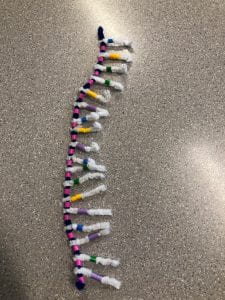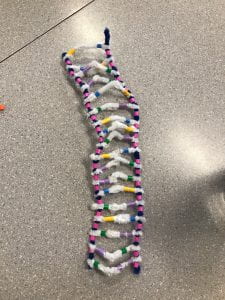 Loading...
Loading...
Cell Size Lab Reflection
 Loading...
Loading...
 Loading...
Loading...
Time-lapse of agar: https://youtu.be/Nr1cLJ3mCUM
Cells need to be small because they rely on diffusion for getting substances into and out of their cells. When a cell grows, there is less membrane for the substances to diffuse through resulting in the centre of the cell not receiving the substance that it needs. Diffusion is less efficient cell processes slow down and the cell stops growing. the cell then needs to divide into 2 smaller cells, which each have a larger surface area to volume ratio and can diffuse materials more efficiently. As we see in our agar the smaller cube is all pink where as the bigger cube is not the same shade of pink throughout. Cells that are smaller are more efficient for diffusion. Their small size means they have a larger SA:V ratio and is important for the materials to move into and out of the cell by diffusion and active transport. Smaller molecules diffuse faster than larger molecules. The smaller molecules are able to move more quickly at a given temperature than larger molecules, allowing them diffuse across the membrane with greater speed.
As we see in this photo the smaller pieces of agar and the same shade of pink throughout whereas the larger pieces have lighter shades of pink in the middle.
Some factors that can affect how materials diffuse into cells are:
1. Concentration gradient
2. Permeability of the cells to the materials
3. Mobility of the material (if it’s a solid that’s stuck onto something big, it’s not going to diffuse into a cell).
4. Temperature (if your tissue sample is frozen solid, you’re not going to be getting diffusion)
5. Pressure (this probably should come under “filtration” rather than “diffusion”)
6. Presence of transport proteins in the membranes of the cells for the materials
7. Cell size and volume
As we see in this photo we can see our agar cubes in a liquid of NaOH and they are at room temperature. We stirred it with a wooden stick at times.
When you increase the size you increase the surface area therefore increasing the volume. The larger the cell the harder to diffuse keeping the cell smaller will decrease the surface area to volume ratio making it easier to diffuse.
You have three cubes, A, B, and C. They have surface to volume ratios of 3:1, 5:2, and 4:1 respectively. Which of these cubes is going to be the most effective at maximizing diffusion, how do you know this?
The most effective cell would be cell C. Although the surface area is larger the volume is still small making diffusion possible effectively. The bigger SA with a small volume the better as it has more SA for diffusion to take place and a small volume.
Our cells are different shapes and have different purpose cells can adapt by diving.
Why can’t certain cells, like bacteria, get to be the size of a small fish?
Because the larger the cell the harder it is to undergo diffusion. Want to maintain a stable SA:V ratio.
What are the advantages of large organisms being multicellular?
Rate of diffusion is higher allows to be efficient and can be more specialized. Being larger has it benefits as it can minimize the risk of becoming prey. Being multicellular allows an organism to develop a higher level of adaptation to its surroundings. This is known as cell complexity and can lead to an organism becoming more intelligent via contact with its surroundings. When talking about evolution, this is where multicellular organisms have the advantage as the many types of cells contained in a complex cellular organism enable it to adapt, change and survive.This means that a single cell does not need to perform all of the functions required to survive and instead works in harmony with millions of other cells with each taking on its own unique role.
 Loading...
Loading...
DNA and Protein Synthesis
DNA also is known as Deoxyribonucleic acid is a molecule composed of two chains that coil around each other to form a double helix carrying genetic instructions for the development, functioning, growth and reproduction of all known organisms and many viruses. DNA is the control molecule of life. DNA has three major functions: Controls cellular activities (including reproduction), carries a “code” that contains genetic instructions, DNA from male/ female together become genetic information in sexual reproduction. The Structure of DNA was determined by James Watson and Francis Crick in the early 1950s. DNA is a polynucleotide; each nucleotide (nucleotide is a compound consisting of a nucleoside linked to a phosphate group. Nucleotides form the basic structural unit of nucleic acids such as DNA) (Fun fact about nucleotides is that Chemo molecules have a similar shape to nucleotides) is a complex of three subunits—phosphoric acid (phosphate), a pentose sugar (deoxyribose), and a nitrogen-containing base. There are four possible bases: two are purines with a double ring, and two are pyrimidines with a single ring. DNA has 2 strands, and the 2 strands twist around one another in the form of a double helix. (Appears twisted as we see in this  photo) —————–>
photo) —————–>
The strands are held together by hydrogen bonding between the bases: A pairs with T by forming two hydrogen bonds, and G pairs with C by forming three hydrogen bonds, or vice versa. This is called complementary base pairing. It is important that A pairs with T and not another Purine/ Pyrimidine as that won’t create hydrogen bonds. COMPLEMENTARY BASE PAIRING: new nucleotides move in to pair up with bases of each template strand of DNA. These new nucleotides are always floating around within the nucleoplasm. ——–>
——–> 
(in this photo we observe 2 sugar-phosphate backbones, complimentary paired before they were unpaired nucleotides)
The bases in DNA pair in such a way that the phosphate-sugar groups are oriented in different directions. This means that the strands of DNA end up running antiparallel to one another, with the 3 ́ end of one strand opposite the 5 ́ end of the other strand. There are leading strands and lagging strands. The leading strand continues as DNA “unzips”, whereas the lagging strand forms fragments as the DNA unzips, ligase is used to glue the fragments. Lagging strand and Leading strand run in opposite directions as they are antiparallel to one another.
These models help to model the DNA structure as we can see double helix bonds, antiparallel to one another, complementary base pairing. Some changes we can make to make the structure more accurate is changing the sizes of the beads used to make it more realistic. The white pipe cleaner to represent hydrogen bonds could be thinner as hydrogen bonds are weak. DNA is extremely long so the size and is not accurate however it would be almost impossible to create such DNA to be that long.
DNA replication is one of the many actions of DNA. DNA replication is when exact copies of DNA are produced. The double-stranded structure of DNA helps replication because each strand can serve as a template for the formation of a complementary strand. DNA replications undergo the following steps unwinding, complementary base pairing, and joining. DNA replication must occur before a cell can divide. Each new double helix is composed of an old (parental),strand and a new (daughter) strand. 
As we see in this photo parental DNA is unzipped and the new nucleotides are now pairing with those in parental strand.
There are 3 steps to make DNA replication:
2. Complementary base pairing. New complementary nucleotides, always present in the nucleus, fit into place by the process of complementary base pairing.
3. Joining. The complementary nucleotides join to form new strands. This step is carried out by an enzyme called DNA polymerase.
As we see in this photo when synthesis is complete there will be 2 identical double helix strands. (Twisted shape)
(complimentary base pairing)
We showed the phosphate bonds and the nucleotides joining at the same time. We can improve this activity by showing how to unzip the stands differently as this is inaccurate. As well as the sizing is inaccurate. Hydrogen bonds can be represented differently perhaps we can draw lines with a black sharpie on them to show that they are weaker.
As we see in this photo hydrogen bonds are represented using a dotted line we could also draw this on the white pipe cleaners.